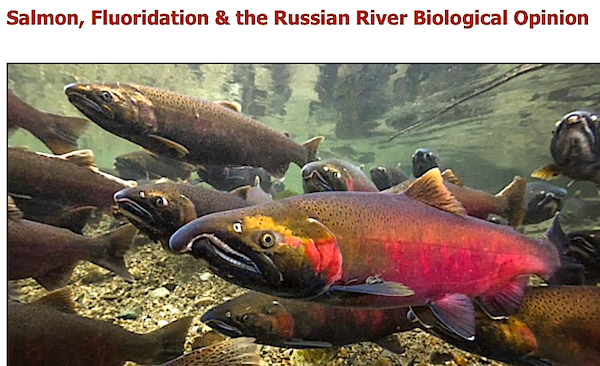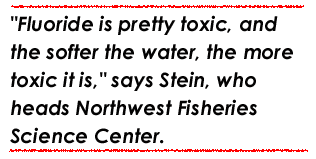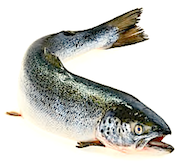Home / Salmon and Fluoridation – Prof. Paul Engelking

University of Oregon Professor Paul Engelking
says – fish and fluoride don’t mix.
Engelking is especially worried that tributaries,
key to salmon spawning, would hold higher
concentrations of fluoride because
there would be less dilution.


Original ⇒ HERE
THE ENVIRONMENT
 STONED SALMON, & A PISSED ENVIRONMENTALIST
STONED SALMON, & A PISSED ENVIRONMENTALIST
Spurred by fish concerns, enviros are sounding the alarm
over an innocuous-sounding chemical:
……….Willamette Weekly- NICK BUDNICK
…….n..E-mail: engelki@uoregon.edu
Paul Engelking sadly explains why he dropped one of his favorite pastimes.
……….“The fish have enough problems,” he says,
……….“without me trying to put them on a hook.”
.
Engelking, a chemistry professor at the University of Oregon, can walk you down the familiar list: destruction of habitat by loggers, toxic runoff from cities, fertilizers and pesticides from farms.
And now this: Fluoride.
Engelking is the scientific muscle behind a number of environmentalists opposing Senate Bill 99, a bill that would mandate adding the cavity-fighting chemical to Oregon’s supplies of drinking water.
The enviros have nothing against healthy teeth. They’re simply questioning whether the perceived benefits of water fluoridation are worth the risk it poses to fish–particularly salmon.
“My concern about fluoridation is this is just one more nail in the coffin,” says Engelking. “And there are a lot of other people lining up to put nails in. It will be a miracle if we go another 50 years and still have a salmon run in Oregon.”
Fragile, heroic and breathtakingly beautiful, salmon are the Jodie Foster of the fish world. The numbers of chinook and coho salmon have plummeted in the Northwest since the turn of the century. In 1999, with nine Northwestern runs of salmon and steelhead on the brink of extinction, the federal government placed them on the endangered species list.
Gov. John Kitzhaber has made salmon recovery a priority; Mayor Vera Katz used her State of the City address to designate Willamette River recovery a priority, citing a goal of “abundant salmon.”
Engelking argues that such goals will be undermined if lawmakers pass SB99, a seemingly innocuous measure to add fluoride to Oregon’s drinking water. It’s an argument that fluoridation proponents dismiss as sheer lunacy.
“There have been no studies to say this has been detrimental to fish life,” asserts Dr. H. Whitney Payne, the state dental director who has been spear-heading SB99.
In reality, however, there have been several studies saying just that, including one in Oregon that dates back nearly 20 years. The studies have found that even small amounts of fluoride, which is an anaesthetic, make fish, particularly salmon and rainbow trout, dazed and stupid (well, more stupid). And scientists say the hazards are much greater in Northwestern states.
John Stein, a National Marine Fisheries Service ecotoxicologist in Seattle, says water in western Oregon and Washington is unusually “soft,” a quality that increases the amount of fluoride absorbed by the fish that swim in it. “Fluoride is pretty toxic, and the softer the water, the more toxic it is,” says Stein, who heads the environmental conservation division at the NMFS’s Northwest Fisheries Science Center.
Fluoride’s threat to salmon is taken so seriously in Canada that British Columbia set a special soft-water standard of 0.2 parts per million. Les Swain, water quality manager of the B.C. Ministry of Environment, says some of the most compelling evidence for that decision came from Oregon.
Between 1982 and 1986, Douglas Dey and a fellow NMFS biologist conducted a groundbreaking study of fluoride’s environmental effects at the John Day Dam on the Columbia River. His study won an award from the American Fisheries Society, an association of fisheries biologists.
Dey set out to solve a mystery. Why were so many salmon dying at the dam?
He discovered that low levels of fluoride emitted by an aluminum smelter upstream were making the salmon too stoned and lethargic to climb fish ladders. It took the dazed critters about a week to traverse the dam, compared to the usual one day–and more than 50 percent of the salmon died before making the trip.
Once the smelter above the dam was forced to reduce its fluoride emissions, the salmon death rate was cut by a factor of 10. Subsequent studies confirmed fluoride’s effects and found that salmon, when given a choice, avoid fluoridated waterways, says Dey.
“It’s a serious problem when the salmon can’t even negotiate the fishway because of a very small amount of toxin,” says Bill Bakke, a founder of Oregon Trout who currently heads the Native Fish Society of Oregon. Bakke, one of the few environmentalists contacted by WW who had heard of Dey’s study, opposes SB99, saying that the risk posed by fluoridation “can’t be tolerated if we’re going to recover the fish.”
The idea behind fluoridating water is that whenever we quench our thirst from the tap, we’ll slow down the cavity-causing bacteria in our mouth.
The problem is that 99 percent of the fluoride goes right down the drain and into our rivers, as sewage-treatment plants don’t remove the chemical. Studies have shown that sewage plants in fluoridated communities can emit fluoride at about 1.2 parts per million–six times the level allowed in British Columbia.
Although the fluoride is diluted well downstream, our major rivers already have traces of fluoride from sources that include smelters and microchip factories. Engelking’s testing on the Willamette River, for example, has found levels of fluoride at 0.1 and 0.2 ppm, already pushing what salmon can handle.
Engelking is especially worried that tributaries, key to salmon spawning, would hold higher concentrations of fluoride because there would be less dilution. The Tualatin River, for example, already tests as high as 0.5 ppm fluoride.
Travis Williams, executive director of Willamette Riverkeeper, says the risks to salmon should be balanced against doubts over the effectiveness of fluoridation.
In the last six months, a British government study, considered the most comprehensive fluoride review ever, echoed a Canadian government study in saying the benefits of fluoridation and evidence for its safety are much less than previously thought.
It prompted an ABC News commentary which proclaimed that “the required level of evidence is just not there” to make the case for fluoridation.
“It makes you wonder,” says Williams. “Would we get a better bang for the buck if kids got free toothpaste, with better education to brush every day?”
Williams isn’t the only one posing such questions. Elisa Dozono, spokeswoman for Mayor Vera Katz, says lawmakers need to look at Dey’s study as they consider SB99. “The mayor is concerned about this,” she says, “and believes that if there could be an impact on Portland’s fish recovery efforts, it should be part of the discussion.”
Gov. John Kitzhaber has not taken a position on the bill.
⇓ This is a good and important read.
Dr. Engelking’s correspondence with the Oregon government.
Read this in conjunction with our item on »⇒ Anorexia





 STONED SALMON, & A PISSED ENVIRONMENTALIST
STONED SALMON, & A PISSED ENVIRONMENTALIST








